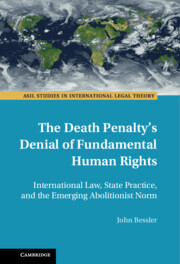 The Death Penalty's Denial of Fundamental Human Rights
The Death Penalty's Denial of Fundamental Human Rights The Death Penalty’s Inherently Cruel and Torturous Characteristics
Published online by Cambridge University Press: 01 December 2022
This chapter describes the immutable characteristics of capital punishment, which kills people and uses death threats by state actors. Death threats are ordinarily treated as unlawful acts, with threats of impending death treated as psychological torture where a person is helpless to prevent death. The chapter discusses how mock executions and various corporal punishments are already treated as torturous acts, including by laws and legal commentators. After discussing the duty of government officials to protect people, including inmates, from harm, as well as how jurists in multiple jurisdictions have recognized the death row phenomenon (i.e., the suffering associated with prolonged stays on death row), the chapter describes how countries have refused to extradite individuals without assurances that the death penalty will not be sought. The U.N. Convention Against Torture and Other Cruel, Inhuman or Degrading Treatment or Punishment contains a "lawful sanctions" carve-out to the definition of torture, but case law makes clear that lawful sanctions cannot themselves amount to torture. The chapter argues death sentences inflict severe pain and suffering amounting to torture.
To save this book to your Kindle, first ensure [email protected] is added to your Approved Personal Document E-mail List under your Personal Document Settings on the Manage Your Content and Devices page of your Amazon account. Then enter the ‘name’ part of your Kindle email address below. Find out more about saving to your Kindle.
Note you can select to save to either the @free.kindle.com or @kindle.com variations. ‘@free.kindle.com’ emails are free but can only be saved to your device when it is connected to wi-fi. ‘@kindle.com’ emails can be delivered even when you are not connected to wi-fi, but note that service fees apply.
Find out more about the Kindle Personal Document Service.
To save content items to your account, please confirm that you agree to abide by our usage policies. If this is the first time you use this feature, you will be asked to authorise Cambridge Core to connect with your account. Find out more about saving content to Dropbox.
To save content items to your account, please confirm that you agree to abide by our usage policies. If this is the first time you use this feature, you will be asked to authorise Cambridge Core to connect with your account. Find out more about saving content to Google Drive.